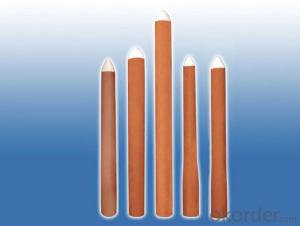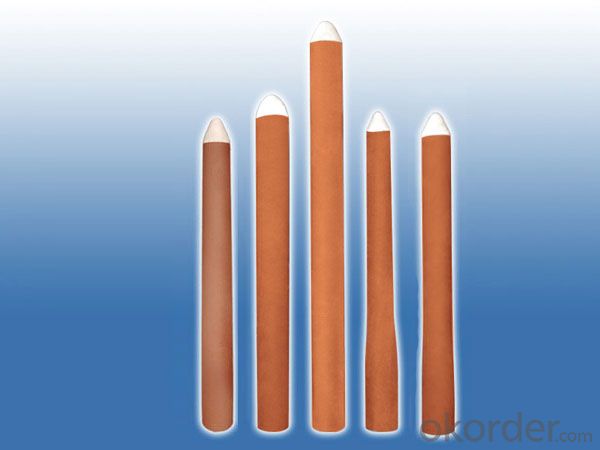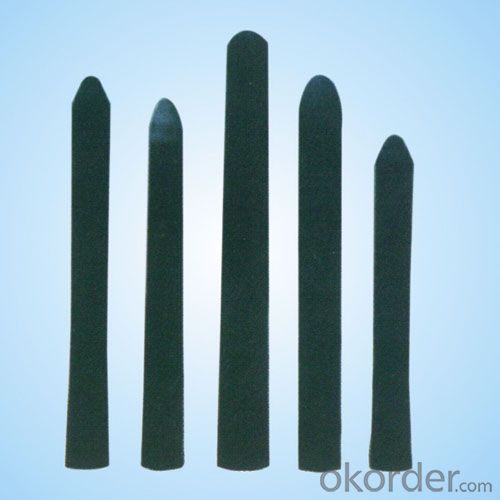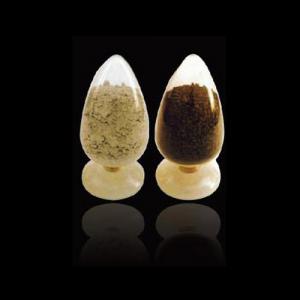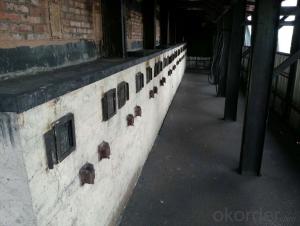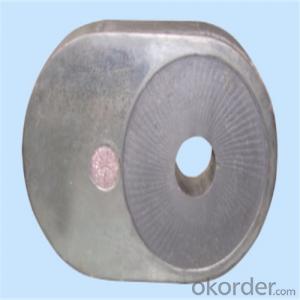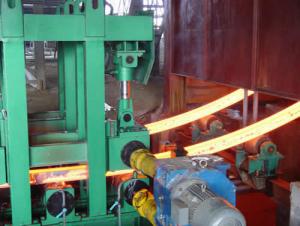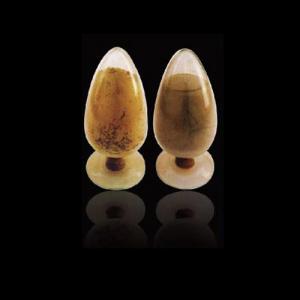Monoblock Stopper for continuous casting
- Loading Port:
- Shanghai
- Payment Terms:
- TT OR LC
- Min Order Qty:
- 10 set
- Supply Capability:
- 50000 set/month
OKorder Service Pledge
OKorder Financial Service
You Might Also Like
Description:
1.excellent thermal shock resistance;
2.excellent mechanical properties and resistance to vibration
3. long service life
Monoblock stopper is one of the important steel flow regulation components, and to meet the particularly demanding operating conditions, we manufacture varieties of stoppers with customised specifications to suit the different designs of our customers' tundishes
To facilitate customisation, during our manufacturing process, we apply different mixtures of aluminia or magnesia to the nose of our stoppers for our customers, enabling them to cast various types of steel.
The characteristics of the stopper are as follows:
PARMETER | Major portion | Stopper head | Stopper head | Stopper head |
F.C+SiC (%) | 20 | 10 | 20 | 12 |
Al2O3 (%) | 68 | 80 | ||
ZrO2 (%) | 72 | |||
MgO (%) | 75 | |||
apparent porosity(%) | 15 | 14 | 16 | 15 |
bulk density(g/cm3) | 2.35 | 2.80 | 3.30 | 2.70 |
CCS (Mpa) | 27 | 26 | 27 | 25 |
MOR (Mpa) | 8.0 | 8.0 | 9.0 | 8.0 |
The stopper head is the key part. Standard materials are:
Alumina carbon suitable for ordinary steel flow control
Zirconium carbon suitable for special alloy steel flow control
Magnesia carbon suitable for Ca-treatment steel flow control
- Q: How do monolithic refractories protect lining in ladles and tundishes?
- Monolithic refractories play a crucial role in protecting the lining in ladles and tundishes through their unique properties and characteristics. These refractories are composed of a single, solid piece, as opposed to traditional brick or tile linings, which consist of individual units. One of the key ways in which monolithic refractories protect the lining is through their high density and low porosity. This property ensures that the refractory material acts as an effective barrier against the penetration of molten metal and slag. By preventing the infiltration of these corrosive substances, the monolithic refractory shields the lining from chemical attack, ensuring its longevity and performance. Additionally, monolithic refractories have excellent thermal shock resistance. Ladles and tundishes are subjected to extreme temperature fluctuations during the steelmaking process, as molten metal is poured and then allowed to cool. The ability of monolithic refractories to withstand these rapid temperature changes without cracking or spalling is vital in protecting the lining from thermal damage. Furthermore, monolithic refractories offer superior strength and mechanical properties. Ladles and tundishes are subjected to various mechanical stresses, such as the weight of the molten metal, the movement of the refractory lining during pouring, and the impact of scrap or additives. The robustness of monolithic refractories allows them to withstand these forces, preventing any structural failure or damage to the lining. Another advantage of monolithic refractories is their ease of installation. Unlike brick or tile linings, which require meticulous jointing and careful placement, monolithic refractories can be applied as a single, cohesive layer. This seamless application ensures a uniform protective barrier, eliminating weak points or gaps that could compromise the lining's integrity. In summary, monolithic refractories protect the lining in ladles and tundishes by providing a dense, impermeable barrier against the penetration of molten metal and slag. Their thermal shock resistance, mechanical strength, and easy installation contribute to the overall durability and longevity of the lining, ensuring its effective performance in the demanding steelmaking environment.
- Q: How do monolithic refractories perform in aluminum holding furnace applications?
- Monolithic refractories perform exceptionally well in aluminum holding furnace applications due to their high thermal conductivity, excellent resistance to thermal shock, and superior mechanical strength. They can withstand the extreme temperatures and harsh chemical environments found in these furnaces, ensuring long-lasting and efficient operations. Additionally, monolithic refractories offer easy installation and maintenance, making them a preferred choice in aluminum holding furnace applications.
- Q: In iron and steel industry, the main raw materials for blast furnace ironmaking are iron ore, coke and limestone. What's the use of limestone here?
- CaCO3 CaO + CO2 =C = 2CO + CO2Fe2O3
- Q: How do monolithic refractories impact the quality and performance of iron and steel products?
- The quality and performance of iron and steel products rely heavily on monolithic refractories. These refractories are designed to withstand extreme temperatures and harsh conditions, making them indispensable in the iron and steel industry. To begin with, monolithic refractories contribute to the overall quality of iron and steel products by providing exceptional thermal insulation. They help maintain a consistent and controlled temperature during the manufacturing process, which is especially crucial in blast furnaces where temperatures can reach up to 2,000 degrees Celsius. By effectively insulating the furnace walls, monolithic refractories minimize heat loss and ensure efficient energy utilization. As a result, the products have higher quality and improved mechanical properties. Additionally, monolithic refractories offer superior resistance to chemical and physical wear. In the steelmaking process, the molten metal and slag can be highly corrosive, leading to erosion and deterioration of the refractory lining. However, monolithic refractories are engineered to withstand such aggressive environments, providing excellent resistance to chemical attack and mechanical stress. By preserving the integrity of the lining, they prevent contamination and extend the lifespan of the furnace or ladle, ultimately enhancing the quality of the final iron and steel products. Moreover, monolithic refractories allow for greater design flexibility and ease of installation. Unlike traditional refractory bricks that require precise placement and fitting, monolithic refractories can be applied as a single, cohesive material. This enables the creation of more intricate shapes and structures, optimizing furnace design and enhancing thermal efficiency. Additionally, the ease of installation reduces downtime during maintenance and repairs, ensuring uninterrupted production and minimizing disruptions to the manufacturing process. In conclusion, monolithic refractories have a significant impact on the quality and performance of iron and steel products. They provide exceptional thermal insulation, resist chemical and physical wear, and offer greater design flexibility. By maintaining consistent temperature environments, preventing contamination, and enabling efficient production processes, monolithic refractories contribute to the production of high-quality iron and steel products that meet the rigorous demands of various industries.
- Q: How do monolithic refractories improve the efficiency of ladle and tundish preheating furnaces?
- Monolithic refractories greatly contribute to the efficiency of ladle and tundish preheating furnaces. These refractories, made from a single material, are easily installed, repaired, and replaced, making them versatile and cost-effective. The efficiency of these furnaces is improved thanks to the outstanding thermal insulation properties of monolithic refractories. With low thermal conductivity, they effectively retain heat and prevent its escape. This insulation capability ensures an efficient preheating process, reducing energy consumption and costs by minimizing heat loss. Additionally, monolithic refractories possess high thermal shock resistance, which is crucial in ladle and tundish preheating furnaces. These furnaces experience rapid temperature changes during the pouring of molten metal, which can lead to cracking or failure of traditional refractories. However, monolithic refractories are specifically designed to withstand thermal shock, remaining intact and maintaining their insulating properties even in extreme conditions. This durability reduces downtime and maintenance requirements, thus enhancing overall efficiency. Furthermore, monolithic refractories provide a seamless and uniform lining surface, improving heat transfer within the furnace. The absence of joints or seams reduces the risk of heat leakage and ensures even distribution of heat throughout the lining. This promotes uniform heating of the ladle or tundish, allowing for more efficient preheating and better temperature control. In conclusion, the use of monolithic refractories in ladle and tundish preheating furnaces results in improved efficiency due to their exceptional thermal insulation properties, high thermal shock resistance, and ability to provide a seamless and uniform lining. These refractories minimize heat loss, reduce energy consumption, and enhance the overall performance of the preheating process.
- Q: How are monolithic refractories used in the repair and maintenance of ladle and tundish linings?
- Monolithic refractories are a type of refractory material that is commonly used in the repair and maintenance of ladle and tundish linings in the steel industry. These linings are crucial components of ladles and tundishes, which are used for the transportation and treatment of molten metal during the steelmaking process. When ladle and tundish linings are subjected to high temperatures and corrosive environments, they can deteriorate over time. This deterioration can lead to various issues such as heat loss, contamination of molten metal, and reduced refractory lining lifespan. To address these problems, monolithic refractories are used as repair and maintenance materials. Monolithic refractories are typically made from a combination of different refractory aggregates, binders, and additives. They are available in various forms, such as castables, gunning mixes, and ramming mixes. These materials are designed to be easily applied and shaped to conform to the specific geometry and dimensions of the ladle or tundish lining. During the repair process, the damaged areas of the lining are removed, and the monolithic refractories are then applied to these areas. Castables can be poured and vibrated into place, while gunning mixes can be sprayed using a high-pressure gunning machine. Ramming mixes, on the other hand, are manually compacted into the lining using a ramming tool. Monolithic refractories offer several advantages in the repair and maintenance of ladle and tundish linings. Firstly, their flexibility allows for easy installation and shaping, ensuring a snug fit to the lining. This helps to maximize the effectiveness of the refractory lining in preventing heat loss and maintaining the integrity of the ladle or tundish. Secondly, monolithic refractories have excellent thermal shock resistance and resistance to chemical attack. This makes them highly durable and capable of withstanding the harsh conditions encountered in ladles and tundishes. They can withstand repeated heating and cooling cycles without cracking or spalling, providing long-lasting protection to the lining. Lastly, monolithic refractories can be easily repaired and replaced when necessary. Their application and removal processes are relatively straightforward, allowing for efficient maintenance of ladle and tundish linings. This helps to minimize downtime and maintain the overall productivity of the steelmaking process. In conclusion, monolithic refractories play a crucial role in the repair and maintenance of ladle and tundish linings. Their ease of application, excellent thermal shock resistance, and resistance to chemical attack make them ideal materials for extending the lifespan and optimizing the performance of these linings in the steel industry.
- Q: How do monolithic refractories respond to changes in thermal conditions?
- Monolithic refractories have the ability to withstand and adapt to changes in thermal conditions. They have a high thermal shock resistance, meaning they can handle rapid changes in temperature without cracking or breaking. Additionally, they exhibit good thermal conductivity, allowing them to efficiently conduct and distribute heat. Overall, monolithic refractories demonstrate a stable and reliable response to changes in thermal conditions.
- Q: Can monolithic refractories be used for the lining of ladle refining furnaces and VOD converters?
- Indeed, ladle refining furnaces and VOD converters can benefit from the utilization of monolithic refractories. These refractories, which consist of a single, uniform material, can be molded and installed in various settings, particularly those involving extreme temperatures such as ladle refining furnaces and VOD converters. The advantage of monolithic refractories lies in their simplicity of application and repair. They can be either cast or gunned in place, offering flexibility in terms of lining design and installation. The lining of ladle refining furnaces and VOD converters requires materials capable of withstanding high temperatures, chemical reactions, and mechanical stresses. Monolithic refractories are well-suited for these demanding applications due to their exceptional resistance to thermal shock and chemical attack. In the case of ladle refining furnaces, monolithic refractories are used to line the vessel in which molten metal is contained and processed. By doing so, these refractories help to maintain the desired temperature and safeguard the ladle from the corrosive effects of both molten metal and slag. Additionally, they serve as insulation to minimize heat loss and enhance energy efficiency. VOD converters, on the other hand, are employed in the steelmaking process to reduce the carbon content of molten steel. Monolithic refractories play a crucial role in lining the converter's vessel and ensuring the maintenance of the required temperature for the decarburization reaction. Furthermore, they provide protection against the corrosive impact of molten metal and slag, thereby guaranteeing the converter's durability and performance. To summarize, monolithic refractories possess outstanding characteristics that make them an excellent choice for lining ladle refining furnaces and VOD converters. Their versatility, ease of installation, and ability to withstand high temperatures and chemical attack render them perfectly suited for these critical applications within the steel industry.
- Q: Can monolithic refractories be customized for specific iron and steel processing requirements?
- Indeed, monolithic refractories possess the capability to be personalized in order to satisfy the distinct demands of iron and steel processing. Renowned for their adaptability and versatility, monolithic refractories can be tailored to accommodate a wide range of applications. The formulation, tangible characteristics, and methods of installation can all be modified to cater to the specific necessities of iron and steel processing. For instance, the selection of raw materials employed in the production of monolithic refractories can be customized to endure the formidable temperatures and harsh chemical environments inherent in iron and steel processing. Diverse types of aggregates, binders, and additives can be chosen to augment the refractory's resistance against thermal shock, erosion, and corrosion. Moreover, the installation technique for monolithic refractories can be adjusted to suit the precise requirements of iron and steel processing. Whether it is gunning, casting, ramming, or spraying, the method of installation can be personalized to guarantee optimal performance and durability in the given application. Additionally, monolithic refractories can also be tailored to particular shapes and sizes to accommodate the various equipment and structures utilized in iron and steel processing. This facilitates a more precise and efficient lining of furnaces, ladles, tundishes, and other vessels, thereby enhancing overall productivity and performance in the process. In conclusion, monolithic refractories can be customized to cater to the distinct requirements of iron and steel processing by modifying their composition, tangible characteristics, installation techniques, and shape. This customization ensures that the refractories can withstand the extreme conditions encountered in these industries, resulting in improved performance, prolonged service life, and enhanced productivity.
- Q: How do monolithic refractories prevent heat loss through radiation?
- High thermal conductivity and low thermal expansion are characteristics of monolithic refractories that prevent heat loss through radiation. These properties enable efficient heat transfer from the hot side to the cooler side, minimizing temperature differences and reducing radiation heat loss. Furthermore, monolithic refractories create a seamless and continuous lining that eliminates gaps and cracks, which would otherwise allow heat to escape. The dense and compact structure of these refractories functions as a barrier, preventing radiation heat transfer. In conclusion, monolithic refractories are essential for maintaining thermal insulation and preventing radiation-induced heat loss in a range of high-temperature applications.
Send your message to us
Monoblock Stopper for continuous casting
- Loading Port:
- Shanghai
- Payment Terms:
- TT OR LC
- Min Order Qty:
- 10 set
- Supply Capability:
- 50000 set/month
OKorder Service Pledge
OKorder Financial Service
Similar products
Hot products
Hot Searches
Related keywords
